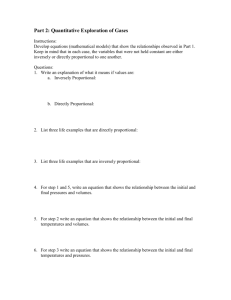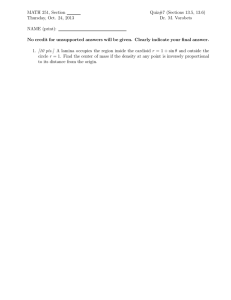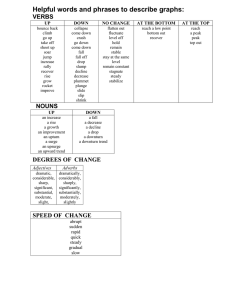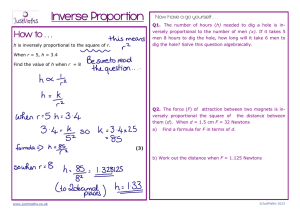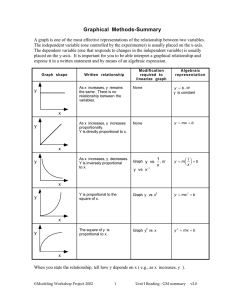Proportion or Variation
advertisement
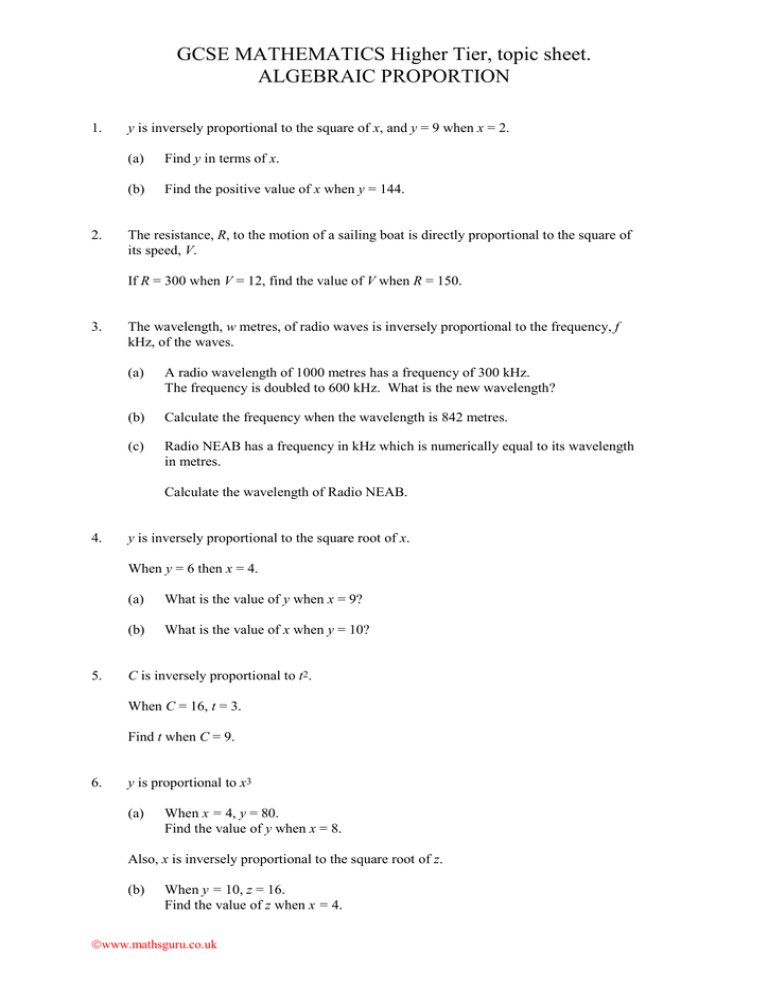
GCSE MATHEMATICS Higher Tier, topic sheet.
ALGEBRAIC PROPORTION
1.
2.
y is inversely proportional to the square of x, and y = 9 when x = 2.
(a)
Find y in terms of x.
(b)
Find the positive value of x when y = 144.
The resistance, R, to the motion of a sailing boat is directly proportional to the square of
its speed, V.
If R = 300 when V = 12, find the value of V when R = 150.
3.
The wavelength, w metres, of radio waves is inversely proportional to the frequency, f
kHz, of the waves.
(a)
A radio wavelength of 1000 metres has a frequency of 300 kHz.
The frequency is doubled to 600 kHz. What is the new wavelength?
(b)
Calculate the frequency when the wavelength is 842 metres.
(c)
Radio NEAB has a frequency in kHz which is numerically equal to its wavelength
in metres.
Calculate the wavelength of Radio NEAB.
4.
y is inversely proportional to the square root of x.
When y = 6 then x = 4.
5.
(a)
What is the value of y when x = 9?
(b)
What is the value of x when y = 10?
C is inversely proportional to t2.
When C = 16, t = 3.
Find t when C = 9.
6.
y is proportional to x3
(a)
When x = 4, y = 80.
Find the value of y when x = 8.
Also, x is inversely proportional to the square root of z.
(b)
When y = 10, z = 16.
Find the value of z when x = 4.
www.mathsguru.co.uk
7.
y is inversely proportional to x2
When x = 2, y = 5.
8.
9.
(a)
Find the value of y when x = 4
(b)
Find the values of x when y = 0.2
A company sells circular badges of different sizes.
The price, P pence, of a badge is proportional to the square of its radius, r cm.
The price of a badge of radius 3 cm is 180 pence.
(a)
Find an equation expressing P in terms of r.
(b)
Calculate the price of a badge of radius 4 cm.
y is proportional to x where x > 0 and y > 0.
When x = 5, y = 12.5.
10.
(a)
Find an equation expressing y in terms of x.
(b)
Calculate x when y = 0.72.
The table shows values of the variables x and y, where y is inversely proportional to x.
x
y
11.
12.
0.4
5.0
(a)
Find an equation expressing y in terms of x.
(b)
Complete the table.
2.5
0.02
The electrical resistance of a wire, R, is inversely proportional to the square of its
diameter, d. When R = 0.5 ohms, d = 6 mm.
(a)
Find an equation expressing R in terms of d.
(b)
(i)
Calculate R when d = 12 mm.
(ii)
Calculate d when R = 12.5 ohms.
(a)
Write the formula y =
kl
(k = constant) in a sentence using the two phrases
t2
‘varies directly as’ and ‘varies inversely as’.
(b)
y = 3 when l = 12 and t = 2.
www.mathsguru.co.uk
Find the value of y when l = 20 and t = 5.
SOLUTIONS / ANSWERS.
1.
(a)
If y is inversely proportional to the square of x, then y =
k
and thus 36 = k.
x2
36
This implies that
y = 2 .
x
36
If y = 144 then
144 = 2
x
144x2 = 36
36
1
=
.
and thus
x2 =
144
4
1
1
Hence
x =
or x = .
2
2
1
Therefore the positive value of x is .
2
Put x = 2, y = 9 to get
(b)
k
for some constant k.
x2
9 =
2.
We have that R is directly proportional to V2 and thus R = k × V2 for some constant k.
Put V = 12 and R = 300 to get 300 = k × 122 = 144k.
300
25
which cancels down to
.
and thus k =
144
12
25 2
Therefore R =
V.
12
3.
(a)
(b)
(c)
4.
5.
6.
k
300000
. Put w = 1000, f = 300 to get that k = 300 000 and thus w =
.
f
f
Now put f = 600 to get w = 500 metres.
f = 356.2945368 kHz.
300000
and thus w2 = 300000.
If f = w then w =
w
Square-rooting gives w = 547.7… metres.
w=
k
.
x
Put y = 6 and x = 4 to get k = 12 etc.
(a)
y = 4.
(b)
x = 1.44.
y=
k
.
t2
Put C = 16 and t = 3 to get k = 144 etc.
When C = 9, t = 4.
C=
y = k × x 3.
(a)
Put y = 80 and x = 4 to get k = 1.25 etc.
y = 640.
(b)
Use y = 1.25x3 to get that when y = 10, x = 2.
So we have that when z = 16, x = 2.
Now use the fact that x is inversely proportional to the square root of z to get that
x=
8
.
z
Finally put x = 4 to get
www.mathsguru.co.uk
z = 2 and hence z = 4.
7.
{y =
(a)
(b)
20
}
x2
y = 1.25.
x = 10 or x = 10.
8.
(a)
(b)
P = 20r2.
320 pence or £3.20.
9.
(a)
(b)
y = 2.5 × x.
x = 0.288.
10.
(a)
y=
(b)
11.
12.
2
.
x
x
y
0.4
5.0
2.5
0.8
100
0.02
18
.
d2
(a)
R=
(b)
(i)
(ii)
(a)
Note that k being a constant means that it is a fixed value which does not
change.
y varies directly with l and inversely as t2.
Put y = 3, l = 12 and t = 2 to get
12k
3 =
22
12k
i.e. 3 =
= 3k.
4
l
This means that k = 1 and hence y = 2 .
t
20
20
4
= .
Now put t = 5 and l = 20 to get y = 2 =
25
5
5
(b)
www.mathsguru.co.uk
R = 0.125.
d = 1.2.
